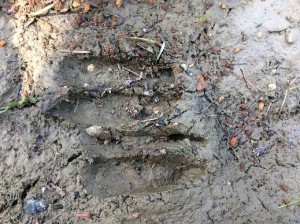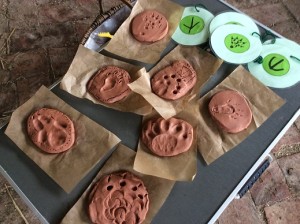
It’s been a wonderful season for wild food foraging. Harvesting reminds us that we are part of nature and the importance of taking only what you need. Many animals are also busy collecting and eating this bounty of autumn foods to prepare for the winter ahead. As many mammals are nocturnal or very secretive now is a good time to look for feeding signs and animals tracks to see what’s about. Read on for ideas and how to improve your detecting skills:
Fantastic tracks: A good introduction to animal footprints is to use an identification guide such as Fantastic tracks or the FSC guide to British mammal tracks and signs. Give everyone a different footprint picture which they need to match up with the guide to discover the identify of their animal. Does the print have 4 or 5 toes? Is it a forefoot or hind foot? Or is it a cloven hooved animal? This can lead into discussion about the size and weight of the animal – small and light mammals such as mice and squirrels leave very light impressions compared to a badger or deer.
Nature detectives: Ready with magnifier glasses, collecting pots, and I.D. guides, set the group the challenge to look for animal tracks and signs. Small paper bags are helpful for collecting nibbled leaves, nuts/seeds and feathers. A camera / IPad can be used take photographs of footprints, tracks and droppings. Direct the group to look along fencelines, especially wire, where animal hair is often snagged and pulled out where an animal has squeezed under a fence.
Evidence table: Use white collection ‘evidence’ trays set up on a table where the group can share and sort through their findings. A fun idea is to have labelled ‘evidence bags’ which helps to protect fragile findings. Create a crime scene scenario where the group looks at the evidence to decide which animals are the predators and who is their prey? This creates lots of discussion.
Animal footprints: Animal tracks are often found in mud. Find a nice muddy patch that’s not too wet and practice identifying signs by making your own tracks. The heel of a hand makes a good palm pad impression and fingers for toe pads. Sticks can be used to make claw prints. Then challenge group to guess each other’s tracks. Top tip: the soft and crumbly earth from mole hills is perfect – flatten the mound gently before making your animal footprint.

Footprint sand trap: Choose a place where there is a well-defined track. Animals such as badgers and foxes have regular paths they patrol. Put a layer of damp sand and/or earth from a molehill over a section of the path and smooth out to create a firm surface for a footprint. The exciting part is waiting and checking the sand trap the next morning for any signs.
Caught in action: Use a motion triggered trail camera to capture images and even footage of visiting wildlife. Purchase a camera that can be shared with another school/group or contact your local Mammal Society Group who can often loan cameras out. Images can help confirm clues and observations, and footage can reveal interesting and new animal behaviour. Maybe your visiting hedgehog is actually two hedgehogs but visiting at different times in the evening.
Have fun tracking!
